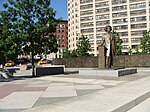Cathedral Parkway–110th Street station (IND Eighth Avenue Line)
1932 establishments in New York CityCentral ParkEighth Avenue (Manhattan)IND Eighth Avenue Line stationsMorningside Heights, Manhattan ... and 4 more
New York City Subway stations in ManhattanNew York City Subway stations located undergroundRailway stations in the United States opened in 1932Upper West Side

The Cathedral Parkway–110th Street station is a local station on the IND Eighth Avenue Line of the New York City Subway. It is located in the Upper West Side and Morningside Heights, Manhattan, at West 110th Street and Frederick Douglass Boulevard at the northwest corner of Central Park. The station is served by the B on weekdays, the C train at all times except nights, and the A train during late nights only.
Excerpt from the Wikipedia article Cathedral Parkway–110th Street station (IND Eighth Avenue Line) (License: CC BY-SA 3.0, Authors, Images).Cathedral Parkway–110th Street station (IND Eighth Avenue Line)
Central Park West, New York Manhattan
Geographical coordinates (GPS) Address Nearby Places Show on map
Geographical coordinates (GPS)
| Latitude | Longitude |
|---|---|
| N 40.800524 ° | E -73.958244 ° |
Address
110th Street
Central Park West
10026 New York, Manhattan
New York, United States
Open on Google Maps










